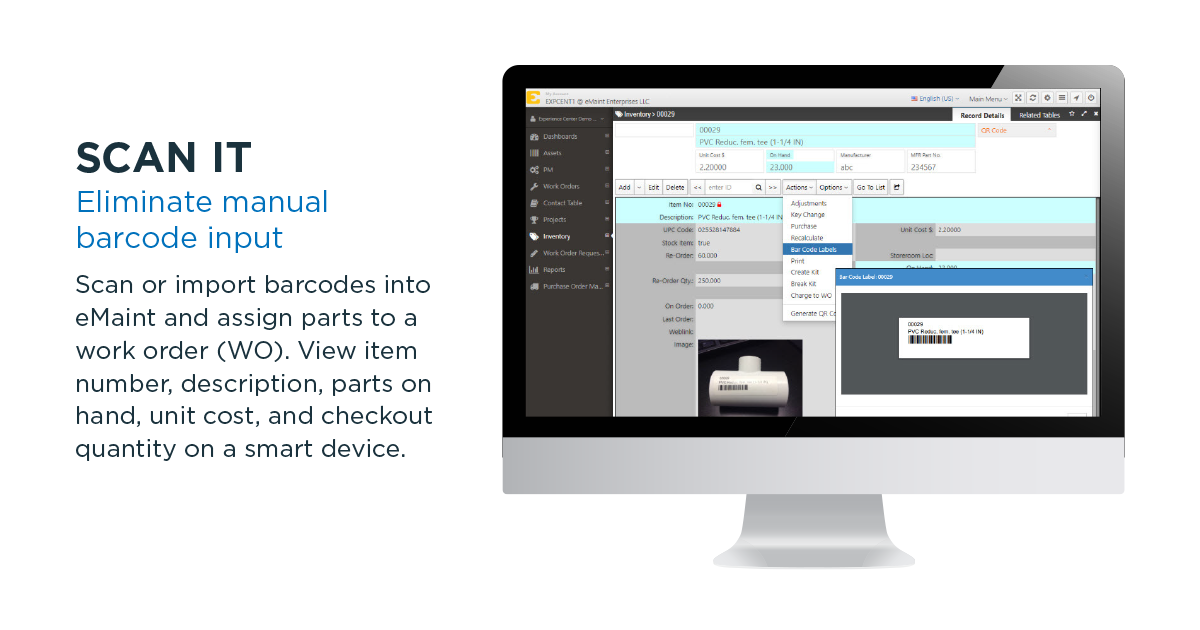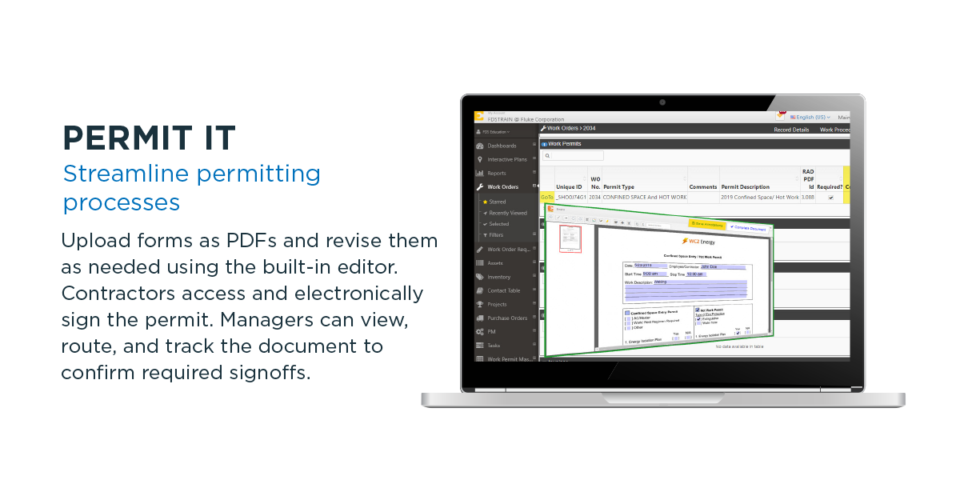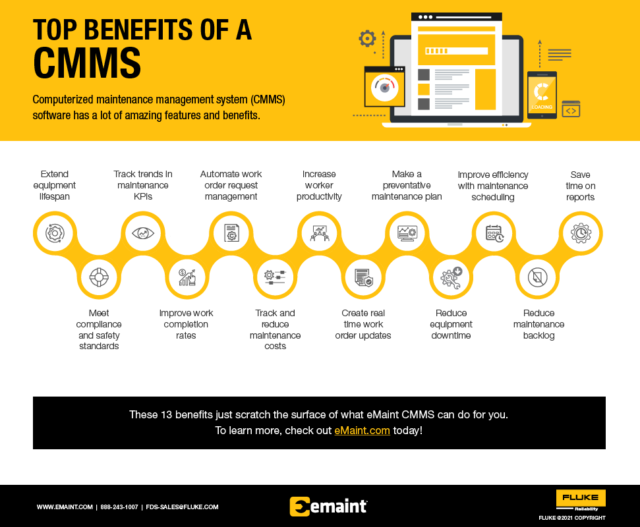The Benefits of CMMS Software
Computerized Maintenance Management System (CMMS) software plays a vital role in maintenance organizations. A CMMS provides a central storage location for the majority of data and information for assets, is used by organizations to manage and control their work and material flows/parts usage processes, and for tracking maintenance activity across the lifecycle of an asset — as a single source of truth. Maintenance, facilities and operations departments can use a CMMS to take charge of assets, work orders, work requests, preventive maintenance tasks, inventory and parts, condition monitoring, and maintenance schedules. All maintenance activities and data can be monitored and analyzed through robust CMMS reporting and dashboard tools.
An intuitive CMMS interface makes managing maintenance easy and intuitive for team members at all levels and roles, from maintenance technicians to upper management. With a mobile CMMS solution, technicians can view and close out work orders from the field, making it very efficient to complete work on-the-go. The maintenance data is then transformed into reports that are meaningful to the organization.
The benefits of a CMMS software are too wide ranging to list in a single article. A computerized maintenance management system is designed to let organizations centralize their maintenance information, facilitate processes and automate tasks. As a result, teams make the best use of people, machinery, and infrastructure, extending equipment lifespans and tracking every aspect of maintenance operations.
Beyond daily maintenance operations, CMMS software also helps track maintenance KPIs and align those metrics with business goals. Armed with easy access to data and insights, organizations can cut costs, boost revenue and ensure compliance, all while optimizing production and uptime.
With such broad potential impact and varying use cases, no list of CMMS benefits could ever be comprehensive, but here we’ve compiled 13 of the top benefits of CMMS software implementation:
- Create real-time work order updates
- Make a preventive maintenance plan
- Improve efficiency with maintenance scheduling
- Track trends in maintenance KPIs
- Automate work order request management
- Increase worker productivity
- Reduce equipment downtime
- Reduce maintenance backlog
- Extend equipment lifespan
- Track and reduce maintenance costs
- Streamline maintenance reporting
- Improve work completion rates
- Meet compliance and safety standards
1. Create Real-Time Work Order Updates
Work orders authorize repairs, maintenance, and operations work. As such, work orders sit at the heart of maintenance programs. With the work order software tools offered by a CMMS, organizations can keep up to date on everything in their queue.
A CMMS moves beyond paper work orders with maintenance planning and scheduling tools that can assign and prioritize work in real time. These work order software tools offer one of the biggest benefits of CMMS. Organizations can take control of work backlog and upcoming work while making improvements and boosting productivity.
2. Make a Preventive Maintenance Plan
Preventive maintenance, also known as preventative maintenance, is work performed regularly to reduce the likelihood of failure. Often, organizations simply assess a machine’s condition to make maintenance decisions. Preventive maintenance takes a more efficient approach, using manufacturer recommendations and average life cycle data to plan preventive maintenance tasks.
CMMS software helps organizations automate recurring preventive maintenance tasks based on time intervals or equipment usage. As a result, maintenance can happen before it’s strictly needed, and organizations can make the most of their budgets, inventories, and schedules to get work done.
3. Improve Efficiency with Maintenance Scheduling
Maintenance scheduling is a key part of any preventive maintenance plan. By using CMMS software for maintenance scheduling, organizations can easily assign work to appropriate labor resources. Maintenance planners and schedulers use CMMS to create and assign work orders to technicians on specific days for set amounts of time. This capability increases resource efficiency as organizations can see both assigned and unassigned work orders on their calendar, and then assign and reassign both employees and outside contractors.
4. Track Trends in Maintenance KPIs
Maintenance KPIS, or key performance indicators, help track goals and key factors for success. A core CMMS benefit is the ability to track metrics so organizations can create baselines and identify opportunities for improvement. Some of the most important maintenance KPIs focus on costs, downtime, backlog and on time work completion rates. With a strong emphasis on tracking maintenance KPIs, organizations have a better chance at hitting their business goals.
5. Automate Work Order Request Management
Work order management tools increase transparency and visibility, so that team members stay on the same page. Scheduling and work order signoffs become fast and simple, and on-time work completion rates increase. Work requests and work order permitting are easier to track and inventory spending is minimized when organizations have the parts they need on hand. They also no longer pay expediting fees when assets go down unexpectedly.
6. Increase Worker Productivity
When an organization sets clear priorities, it lets maintenance focus on the most important work and avoid work stoppages for emergencies or fire drills. With CMMS software, organizations can increase worker productivity by putting their people and resources to the best possible use. Organizations can define a Ranking Index Maintenance Expenditure, or RIME ranking, which makes it simple to prioritize assets and lets maintenance teams streamline their efforts. Technicians also need the right tools and technical documentation to work on a specific asset.
A CMMS helps increase planned preventive maintenance, lower emergency corrective work and ensure the right parts and labor resources are available when equipment is maintained. The combined result is that a CMMS can reduce worker overtime hours and avoid spending limited resources on non-wrench time activities.
7. Reduce Equipment Downtime
Almost every maintenance operation struggles with downtime, as equipment malfunctions and machinery stops operating. In the automotive industry, manufacturing downtime can cost as much as $50,000 per hour. One of the top benefits of CMMS software is that you can use it to prevent failures rather than just reacting to them. As a result, your organization can maximize uptime and increase production.
CASE STUDY:
Hoyt Archery Company is a leading manufacturer of bows and archery accessories. They employ a wide array of skilled craftsmen and engineers designing and crafting the world’s finest compound and recurve bows. The company needed a flexible, affordable, and user-friendly CMMS system to plan and track labor and manage inventory.
Hoyt implemented eMaint in 2009, and using the tracking capabilities of the software, Hoyt was able to build a detailed maintenance history. The company experienced a 40% reduction in downtime, a 77% increase in PM compliance, and much more with the power of eMaint.
8. Reduce Maintenance Backlog
Maintenance backlog is the buildup of all the maintenance work an organization needs to complete to avoid breakdowns and keep up with safety issues. As a maintenance backlog grows, so does the risk of serious and costly failures. Another CMMS benefit is that the software lets organizations easily monitor backlog and take action to reduce it. With control of their maintenance backlog, teams can minimize staffing challenges, firefighting, and lack of work prioritization.
9. Extend Equipment Lifespan
All organizations want to get the most out of their equipment, and a computerized maintenance management system is one of the best ways to do that. A CMMS serves as a central storage location for data and information on assets. It also lets organizations deploy equipment hierarchy and history tracking, as well as attach parts and Bills of Materials to assets.
All assets aren’t created equal, so organizations often use a CMMS to prioritize critical work and be sure it happens first, avoiding costly breakdowns. Another CMMS benefit is that organizations can generate both calendar and meter-based preventive maintenance tasks for their assets. As a result, maintenance managers can be sure all planned maintenance happens on time and as intended, helping extend equipment lifespan.
10. Track and Reduce Maintenance Costs
The ability to track and reduce maintenance costs is another top benefit of a computerized maintenance management system. CMMS software lets organizations easily track and monitor their assets, creating an accurate report of real-time asset health and performance. Using this data, organizations can make data-driven maintenance decisions, cutting down on their asset failures while also lowering maintenance costs. A CMMS also helps minimize spending on inventory because organizations can have necessary parts on hand and avoid paying more to expedite delivery when assets unexpectedly go down.
11. Streamline Management Reporting
In today’s world, it’s almost impossible to manually organize the management of a facility. That task only gets harder with ever-growing mandates to increase maintenance KPIs around things like reducing costs and streaming processes.
However, with a CMMS, maintenance managers can easily find, track and analyze things like costs, labor and assets. Having a central repository for all repair costs and history helps streamline reporting. Maintenance teams can also store detailed info about an asset in a CMMS, including pictures, documents, links, and detailed maintenance tasks.
A CMMS can easily create a range of reports and dashboards. Some of the most beneficial CMMS reports include preventive maintenance summaries, work orders, purchase orders, equipment histories, and labor summaries.
CASE STUDY:
Harley Marine is a leading provider of marine transportation services. The company chose eMaint as the CMMS solution to schedule and track work on their fleet of 70 vessels and over 1,000 assets, and provide reliable work history.
Among other benefits, Harley Marine used eMaint to comply with customer requests for maintenance history on the vessel they are contracting by simply running a report in eMaint. This was a challenging task prior to implementation. Harley Marine also enjoys the ease-of-customization of eMaint CMMS. They have created custom workflows to allow for maintenance schedule deviations when vessels are at sea and weekly management reports that are automatically generated.
12. Improve Work Completion Rates
Another major benefit of CMMS software is the increase in transparency and visibility organizations gain from the work order management tools. A CMMS keeps all team members on the same page. Work order permitting and work requests get easier to track, as do work order signoffs and scheduling, so work completion rates improve. Finally, customer satisfaction rates also increase based on the timely completion of work requests.
CASE STUDY:
AthenianRazak is a real estate services company that consults on, creates and manages real property. The company wanted a CMMS system to track tenant requests through to resolution as well as to schedule and track preventive maintenance activities. In 2009, AthenianRazak decided eMaint would be that system. It provides tracking of maintenance performed on over 30,000 assets at multiple complexes, helped to improve response time and satisfies residents while adhering to budgets, and issues such as backlog and maintenance calls have been reduced.
13. Meet Compliance and Safety Standards
Whether your organization contends with safety, health, quality, or environmental standards, CMMS software is a useful tool to help comply with strict regulatory standards. A CMMS can track everything from work history and calibration schedules, to failures and warranty information for each of an organization’s assets.
By tying multiple Standard Operating Procedures to preventive maintenance schedules, organizations can verify that their work is being carried out correctly. CMMS software is also a simple way to create maintenance reports with the data needed for an organization’s audits and inspections. It even enables electronic signature sign-offs, ensuring that work meets compliance standards.
CASE STUDY:
Herbalife is a global nutrition company that manufactures and sells nutrition, weight management, and skin-care products. With a large number of assets initially coming online in a new facility, Herbalife wanted an easy-to-use CMMS solution that could help manage maintenance efforts for both manufacturing and facility upkeep.
eMaint exceeded the company’s requirements, and was implemented in two short weeks. The software provided Herbalife with a breadth of new benefits. Among them, the eMaint Engineering Services team worked with the Herbalife Quality Control department to successfully validate the system to align with FDA compliance.
CMMS Software: Key to Industrial Maintenance Success
In conclusion, a CMMS records and tracks all organizational maintenance activities by deploying an environment of interrelated program modules designed to facilitate maintenance business processes and the optimal administration of resources such as labor, material, tools and information to achieve sustainable and dependable operational stability. Today’s asset-intensive organizations are making better use of leading-edge, user-friendly, scalable CMMS platforms now than ever before.




